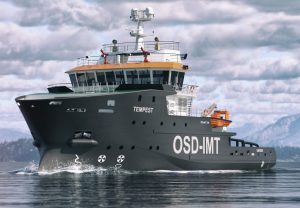The Rebirth of the Compact Ocean Going AHT
 In the history of ocean towage, several vessels stand out. Among them the anchor-handling towage vessels Tempest and Typhoon, which were delivered by Van der Giessen-de Noord to Wijsmuller Offshore & Towage in 1976.
In the history of ocean towage, several vessels stand out. Among them the anchor-handling towage vessels Tempest and Typhoon, which were delivered by Van der Giessen-de Noord to Wijsmuller Offshore & Towage in 1976.
Built to an in-house design by Wijsmuller Engineering, these 48m and 120t bollard pull tugs were used by Wijsmuller Offshore & Towage for rig moves and associated anchor-handling duties. Serving several owners during their long operational careers, the vessels proved their functionality. The Tempest, renamed Jedana, is still sailing today. From 2004 onwards, six tugs based on the same basic design with 100t bollard pull were delivered to various owners. Also the design was used as inspiration for two larger variants of 58 and 65m with 200 and 220t bollard pull.
Ship design & marine consultancy company OSD-IMT originates from Wijsmuller Engineering and is very proud of this legacy. Shifting market demands have brought about changes in the ocean towage business over the years. Based on discussions with prospective clients, OSD-IMT has recently developed design number 7501. Whereas the most recent deliveries were for large and extremely powerful vessels, the OSD-IMT7501 fills a void at the lower end of the market. This compact offshore tug design, with a length of 51m and a maximum bollard pull of 120t, has become OSD-IMT’s modern interpretation of the Tempest and Typhoon. Dedicated purely to towing and anchor-handling duties, it is perfectly suited to supporting installation and decommissioning activities for the oil, gas and renewables markets.
The OSD-IMT7501 incorporates straightforward modern technology to keep things simple and effective. To enhance onboard safety, several design choices were made. The freeboard of the working deck is higher than on similar sized vessels, which gives a dryer aft deck and adds to the stability. The spacious technical and working spaces on board are well laid out in order to create a safe working environment and allow for easy access to equipment. The accommodation is large and provides a comfortable place for 14-20 crew to spend their off-watch time.
This new design also showcases OSD-IMT’s well known S-bow. Apart from being visually recognisable, the transverse profile of the S-bow can be amended to suit specific performance requirements. For the OSD-IMT7501 it provides finer waterline entry angles and offers smooth vessel motions, which result in higher crew comfort. The S-bow also sufficiently flares out towards the top, giving reserve buoyancy forward in rougher seas and providing a practical forecastle deck. At the aft- and midship sections of the vessel a knuckle has been introduced at the waterline. This gives a narrower waterline beam for reduced sailing resistance whilst also providing reserve buoyancy and added stability during anchor-handling duties or in case of heeling. This knuckle also features on many of OSD-IMT’s Azistern tug designs and is the result of extensive tank testing.






